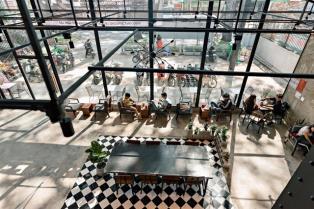Experts estimate that around VND62.2 trillion has been pumped through the OMO channel in the last week of November by the central bank after eight straight months of withdrawing money.

On December 2 the State Bank of Viet Nam issued 14-day bills worth VND18 trillion (US$782.6 million) at an interest rate of 4 per cent through open market operations.
Earlier, from November 18 to November 22, it had made a net cash injection of VND25 trillion ($1.09 billion) into the economy.
Experts estimate that around VND62.2 trillion has been pumped through the OMO channel in the last week of November by the central bank after eight straight months of withdrawing money.
The injections indicated that the liquidity in the banking system had dried up over the last few months, and the central bank’s move has helped reduce lending interest rates on the inter-bank market, which had risen significantly.
On November 26 interest rates on loans of up to one month were up by 0.7-1 percentage points from the previous day to a record high of 4.5 per cent for overnight loans and 4.92 per cent for one-week loans.
Analysts said the lack of liquidity in the banking sector was due to some new policies rolled out by financial authorities.
The central bank issued Circular No.22 stipulating limits and prudential ratios for banks and foreign bank branches.
It has also unveiled a roadmap to gradually reduce the maximum rate of short-term funds that can be used for medium- and long-term loans from 40 per cent to 30 per cent between 2020 and 2022.
It increased the risk ratio for loans given to the real estate sector from 150 per cent to 200 per cent, and the risk ratio for personal loans for home purchase from 50 per cent to 150 per cent.
Another circular too has badly affected the liquidity of banks, especially State-owned: Circular 58 of the Ministry of Finance which took effect on November 1.
In the past the Government would issue bonds and the State Treasury had to deposit the money raised at banks, mainly State-owned.
But according to this new circular, the money collected from issuing bonds has to be kept in a State Treasury account with the State Bank of Viet Nam.
Besides, tax revenues that used to be kept in the collection/payment accounts of the State Treasury at banks for several weeks without interest must now be transferred to the Treasury Single Account (TSA) at the SBV. The TSA is an account into which all revenues of all government agencies goes.
According to the SBV source, before the ministry’s circular took effect, in September 2019 the treasury had deposits of over VND200 trillion in banks.
All these could not have been at a worse time for banks in terms of liquidity requirements since the end of the year is the peak business season when companies require money to produce and stock goods for the festive season and complete payment contracts and pay employees’ and bonuses, experts said.
So the central bank’s strong cash injections would help ease the liquidity pressure, they said.
Rates on the inter-bank market started going down again, with the overnight interest rate in late November at 3.83 per cent and the one-week rate at 3.99 per cent.
SBV cuts interest rate on bank reserves
Besides the above-mentioned monetary policy changes, the central bank on December 2 also issued Decision No. 2497 on the interest rates applicable to compulsory reserves and free reserves, or deposits exceeding the mandatory reserves, kept with it by domestic credit institutions and foreign bank branches.
With effect from December 1 the interest rate on dong reserves has been reduced to 0.8 per cent, down from the earlier 1.2 per cent.
In Viet Nam, the mandatory reserve ratio is 3 per cent of total deposits.
On free reserves, the SBV does not pay any interest.
This is the first time the interest rate on reserves has been cut in 14 years.
The interest rate on foreign currency reserves is also zero though the central bank does pay 0.05 per cent on free reserves.
The central bank has also decided to lower the interest rate on dong deposits held with it by the State Treasury from 1.2 per cent to 1 per cent.
The banking sector’s credit growth in the first nine months of the year was just 8.64 per cent, much below the year’s target of 14 per cent, and the lower interest rate on their reserves is expected to spur lenders, especially those with free reserves, to increase lending rather than deposit at the central bank.
Coupon rates on Government bonds are at very low levels and so the central bank had no reason to keep its reserve interest rate at such a high level, according to analysts.
The cut is also in sync with the current global trend of falling interest rates, with Japan and some European countries even offering negative interest on banks’ free reserves.
Car dealers offer big discounts as inventories bulge
The automobile market has been witnessing a sharp drop in the prices of almost all brands of cars since the beginning of this month as the peak shopping season approaches.
Market observers say dealers are vying with each other to offer lower prices, especially on vehicles in the luxury segment where the cuts range up to a staggering VND500 million.
For instance, discounts of VND80-300 million are offered on Audi, Subaru and Chevrolet cars. Prices of the Toyota Fortuner and Innova and Mazda CX5 are down by VND20-40 million.
Many car traders say they have had to cut prices drastically to liquidate their large inventories.
According to the Ministry of Industry and Trade, the number of imported and locally produced cars skyrocketed between January and November to above 400,000, with imports seeing the highest rise.
Meanwhile, car sales have averaged less than 300,000 annually including this year.
However, dealers’sharp cuts in prices have not had an impact on sales, which have remained under the average levels.
In past years buyers had to pay in advance and wait for months to take delivery or pay extra to get quick delivery.
A salesman at an automobile showroom on Nguyen Van Cu Street in District 5 said he could not sell a single vehicle for the last month.
The situation has been similar at showrooms on Tran Hung Dao and An Duong Vuong streets in District 5 and Cong Hoa Street in Tan Binh District, all of which are packed with vehicles.
Many analysts say customers may wait for further cuts in prices since supply is huge and far above demand.
Others also point out that despite the cuts prices remain out of reach of many people. VNS
Others also point out that despite the cuts prices remain out of reach of many people. VNS





